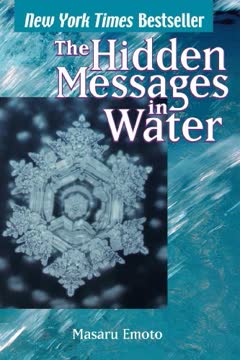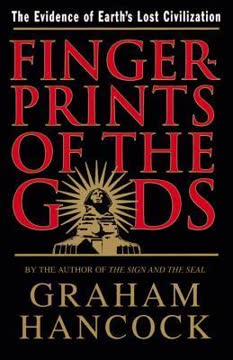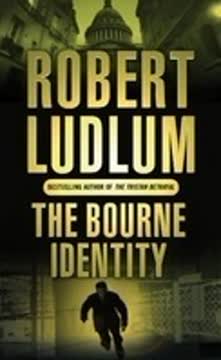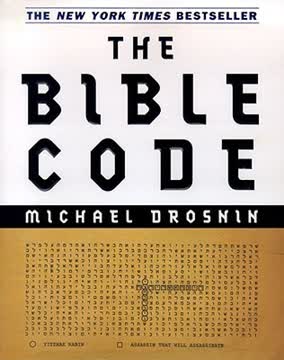Key Takeaways
1. A Hidden Code in the Bible Reveals Future Events
For 3000 years a code in the Bible has remained hidden. Now it has been unlocked by computer - and it may reveal our future.
Ancient secret unlocked. An Israeli mathematician, Dr. Eliyahu Rips, discovered a hidden code within the original Hebrew text of the Old Testament using computer analysis. This code, based on equidistant letter sequences (ELS), appears to contain information about events that occurred long after the Bible was written. The discovery suggests a layer of meaning beyond the plain text, accessible only through modern technology.
Equidistant Letter Sequences. The code is found by removing all spaces from the Hebrew text and searching for words or phrases spelled out by letters separated by a specific, equal number of characters (the "skip distance"). Different skip distances reveal different encoded messages, often forming interconnected "crossword puzzle" patterns of related terms. This method allows for a vast amount of information to be compressed within the finite text.
Potential implications. The existence of such a code, if validated, challenges conventional understanding of the Bible's origins and purpose. It raises profound questions about foreknowledge, determinism, and the nature of reality itself. The initial findings suggest the code might be a form of communication or warning intended for a specific time in history – our own.
2. Scientific Proof Confirms the Code's Existence
Randomization analysis indicates that hidden information is woven into the text of Genesis in the form of equidistant letter sequences. The effect is significant at the level of 99.998%.
Rigorous validation. The initial discovery was presented in a scientific paper, "Equidistant Letter Sequences in the Book of Genesis," co-authored by Rips and Doron Witztum, and published in the peer-reviewed journal Statistical Science. This paper detailed experiments showing that names of famous rabbis and their birth/death dates were encoded together in Genesis against astronomical odds (initially 1 in 4 million, later refined to 1 in 10 million).
Independent corroboration. Skeptical mathematicians and code-breakers, including a senior analyst from the top-secret U.S. National Security Agency (Harold Gans), attempted to disprove the code but instead replicated and extended the findings. Gans, for instance, found that the cities where the rabbis were born and died were also encoded with their names, further confirming the statistical anomaly.
Beyond chance. The consistent appearance of related information encoded together, far exceeding what would be expected by random chance in a text of the Bible's size, convinced initially skeptical scientists. The mathematical evidence suggests that the encoding is intentional, not a product of coincidence or statistical artifact found in any large text.
3. The Rabin Assassination: A Dramatic Validation
On November 4, 1995, came the awful confirmation, a shot in the back from a man who believed he was on a mission from god, the murder that was encoded in the bible three thousand years ago.
A personal warning. The author, Michael Drosnin, personally found the assassination of Israeli Prime Minister Yitzhak Rabin predicted in the code more than a year before it happened. The encoding showed Rabin's full name crossed by the phrase "assassin that will assassinate." Drosnin delivered a letter warning Rabin of the danger.
Prophecy fulfilled. Despite the warning, Rabin was assassinated in November 1995, exactly as predicted in the code. This event served as a brutal and undeniable confirmation for Drosnin and others that the code was real and could foretell specific, dramatic future events.
Details revealed post-event. After the assassination, further searches revealed more details encoded in the same area, including the assassin's name, "Amir," the location, "Tel Aviv," and the Hebrew year of the murder, "5756." This highlighted that while the code predicts, specific details may only become apparent after the event occurs, or require knowing what to look for.
4. The Code Foretells Major Historical Events
In addition to the Sadat and Kennedy assassinations, hundreds of other world-shaking events are also encoded in the bible—everything from world war ii to Watergate, from the holocaust to Hiroshima, from the Moon landing to the collision of a comet with Jupiter.
A historical record. The Bible code appears to contain a detailed record of major events throughout human history, spanning thousands of years after the Bible was written. These include political upheavals, wars, scientific achievements, and natural disasters.
Specific examples:
- Assassinations: John F. Kennedy ("President Kennedy" + "to die" + "Dallas"), Robert F. Kennedy ("R.F. Kennedy" + "second ruler will be killed" + assassin's name "S. Sirhan"), Anwar Sadat (name + assassin's name + date + location).
- Wars & Conflicts: World War II ("World War" + "Hitler" + "Holocaust" + years + major nations), Gulf War (Saddam Hussein + Scuds + date), Watergate ("Watergate" + Nixon + year + "President, but he was kicked out").
- Scientific/Technological Milestones: Moon landing ("Man on Moon" + "spaceship" + "Apollo 11" + date), discovery of gravity ("Newton" + "gravity"), theory of relativity ("Einstein" + "theory of relativity").
Accuracy and detail. The level of detail found in these encodings, often including names, dates, and locations, is presented as evidence against random chance. The consistent appearance of related terms forming coherent messages is a key feature of the code's apparent design.
5. The Bible Code Functions Like an Ancient Computer Program
The Bible is not only a book-it is also a computer program. It was first chiseled in stone and handwritten on a parchment scroll, finally printed as a book, waiting for us to catch up with it by inventing a computer.
Designed for technology. The structure of the code, requiring the removal of spaces and complex searches for equidistant letter sequences across a massive text, suggests it was designed to be deciphered by a computer. This implies the encoder foresaw the development of such technology thousands of years in the future.
Interactive database. The code acts like an interactive database. By inputting a key word (like a name or event), the computer searches the continuous letter strand and reveals related information encoded nearby, forming "crossword puzzle" patterns of interconnected words and phrases. Different skip distances create different matrices of information.
Infinite potential. According to Rips, the amount of information potentially encoded is incalculable, possibly infinite, due to the vast number of possible skip sequences and combinations of interlocking words. We are only accessing the most basic level of this complex system, which may be multi-dimensional, like a hologram.
6. A Warning of Imminent Atomic Holocaust and World War
In the Bible code, only one world capital matches either "World War" or "atomic holocaust" -"Jerusalem."
The ultimate threat. Beyond historical events, the code appears to contain urgent warnings about future dangers, specifically an "atomic holocaust" and a "World War." These threats are repeatedly encoded, often linked to specific years in the near future (e.g., 1996, 2000, 2006).
Jerusalem as the epicenter. The code consistently points to Jerusalem as the central target of this predicted catastrophe. The name "Jerusalem" is encoded with both "atomic holocaust" and "World War," suggesting the Holy City could be the flashpoint for a global conflict.
Potential sources and timing. The code also hints at potential sources of the danger, such as "Libya" and "Kaddafi," and links the threat to the current geopolitical situation in the Middle East. While specific dates are encoded (like 1996, 2000, 2006), the exact timing and inevitability remain uncertain, presented more as probabilities than fixed destiny.
7. The Code Links the Present to the Biblical "End of Days"
In the Bible code, that prediction of the "End of Days" matched "atomic holocaust" and "World War."
Apocalypse encoded. The code connects the current era and the predicted dangers directly to the ancient Biblical prophecies of the "End of Days" or Apocalypse, particularly those found in Daniel and Revelation. The Hebrew year 5756 (1995-1996) is repeatedly encoded with phrases like "in the End of Days."
The "Sealed Book". The Bible itself speaks of a "sealed book" that will be opened at the "time of the End" to reveal future events. The nature of the Bible code, hidden for millennia and requiring modern technology (the computer) to be opened, suggests it might be this prophesied "sealed book."
A time of unprecedented trouble. The convergence of the "End of Days" encoding with warnings of "atomic holocaust" and "World War" in the code aligns with the Biblical description of the End Times as a period of unprecedented global catastrophe. This suggests the code is a specific warning for our generation.
8. Natural Disasters, Including Comet Impacts and Earthquakes, Are Encoded
The Jupiter cataclysm was also foretold in the Bible code, found months before it happened.
Cosmic and terrestrial threats. The code's predictions are not limited to human conflict. It also foretells major natural disasters, including the impact of comets and devastating earthquakes. The collision of Comet Shoemaker-Levy with Jupiter in 1994 was accurately encoded with the comet's name, Jupiter, and the exact date, found months in advance.
Earthquake warnings. "Great earthquake" is encoded with various locations, including major cities like Los Angeles, cities in Japan (Kobe, Okushiri), China, and Israel. Specific years are also linked to these predictions, such as 2010 for Los Angeles and 2000/2006 for Japan and China.
Potential global impact. These natural disasters are sometimes linked to economic collapse or other widespread consequences. The encoding of "economic collapse" with "earthquake struck Japan" suggests a single event could have far-reaching global effects, highlighting the interconnectedness of the predicted dangers.
9. The Code Suggests a Non-Human Intelligence as the Encoder
I am persuaded only that no human could have encoded the Bible in this way.
Beyond human capacity. The complexity of the code, its ability to accurately foretell events thousands of years in the future, and the sheer volume of information encoded within the text are presented as evidence that no human being could have created it. Even with modern supercomputers, encoding the Bible in this manner is deemed impossible.
An ancient encounter. The Bible itself describes its origin as a divine dictation to Moses on Mount Sinai. The code appears to support this, with terms like "computer" encoded in verses describing the creation of the Ark of the Covenant and the writing on the stone tablets, suggesting an advanced technology or "mind" behind the events.
Purpose: Warning, not control. The encoder, whether God or another advanced intelligence, appears to be able to foresee the future but not necessarily control it entirely. The code functions as a warning system, providing information about potential dangers rather than preventing them directly, implying a respect for human free will.
10. The Future is Not Fixed: The Code Offers Probabilities We Can Change
My own guess is that it is only a possibility—that the bible encodes all the probabilities, and what we do determines the actual outcome.
Probabilities, not destiny. Despite the accuracy of past predictions, the code does not seem to present a single, inevitable future. Instead, it appears to encode multiple possible outcomes or probabilities. The same Hebrew letters that spell the year 5756 (1996) also form the question, "Will you change it?"
Evidence of change. The delayed trip of Prime Minister Netanyahu to Jordan, which the code had predicted for a specific date (the 9th of Av, a cursed date in Jewish history) but which was postponed, is cited as potential evidence that events can be altered. The word "delayed" is also encoded with predicted disasters.
Human agency. The message of the code, therefore, seems to be a call to action. By revealing potential dangers, it empowers humanity to make choices and take steps to avert catastrophe. The ultimate outcome may depend on our awareness and our actions, suggesting that free will coexists with foreknowledge.
Last updated:
FAQ
What’s "The Bible Code" by Michael Drosnin about?
- Investigative reporter Michael Drosnin explores a hidden code in the Hebrew Bible that allegedly predicts major world events, both past and future.
- The book details how Israeli mathematician Dr. Eliyahu Rips discovered the code using computer algorithms to search for equidistant letter sequences.
- Drosnin recounts his own five-year investigation, including attempts to warn world leaders about encoded predictions.
- The narrative covers the code’s supposed predictions of events like the Rabin assassination, Gulf War, and even potential future apocalyptic scenarios.
Why should I read "The Bible Code" by Michael Drosnin?
- Unique blend of science, religion, and investigative journalism, offering a fresh perspective on the intersection of faith and mathematics.
- The book raises profound questions about fate, free will, and whether the future is predetermined or can be changed.
- It provides insight into the process of scientific discovery, skepticism, and peer review, especially in controversial fields.
- Readers interested in prophecy, cryptography, or the mysteries of ancient texts will find the book both provocative and thought-provoking.
What are the key takeaways from "The Bible Code" by Michael Drosnin?
- The Bible may contain a hidden code, discoverable only with modern computers, that encodes information about historical and future events.
- The code’s existence has been supported by some mathematicians and code-breakers, but remains highly controversial and unproven in mainstream science.
- The code appears to predict not only past events (like the Holocaust, Kennedy assassinations, and Moon landing) but also warns of possible future catastrophes, such as nuclear war.
- The book suggests that the code is not deterministic; rather, it may encode multiple possible futures, leaving room for human free will and intervention.
How was the Bible code discovered and what is the method described in "The Bible Code" by Michael Drosnin?
- The code was discovered by Dr. Eliyahu Rips, who used computer programs to search the Hebrew Bible for equidistant letter sequences (ELS) that spell out words and phrases.
- The process involves removing all spaces from the text, creating a continuous string of letters, and then searching for words by skipping a set number of letters at regular intervals.
- The method is akin to creating a giant crossword puzzle, where related words and dates intersect in meaningful ways.
- The statistical significance of these findings was tested by comparing results from the Bible to those from other texts, like "War and Peace," with the Bible showing unique clustering of related terms.
What are some of the most significant events claimed to be predicted by the Bible code in Michael Drosnin’s book?
- The assassination of Israeli Prime Minister Yitzhak Rabin, including the name of his assassin and the year, was found encoded before the event occurred.
- Other events include the Gulf War, the collision of comet Shoemaker-Levy with Jupiter, the election of Bill Clinton, the Holocaust, Hiroshima, and the Kennedy assassinations.
- The code also allegedly predicted the Oklahoma City bombing, the Moon landing, and the Watergate scandal.
- Some predictions were found in advance, while others were discovered after the events, raising questions about the code’s predictive power.
How credible is the Bible code according to "The Bible Code" by Michael Drosnin, and what do experts say?
- The code’s existence was published in a peer-reviewed mathematics journal and confirmed by some mathematicians, including a Pentagon code-breaker.
- However, many statisticians and scientists remain skeptical, arguing that patterns can be found in any large text and that the methodology may be flawed.
- The book documents both the support and criticism from experts, highlighting the ongoing debate about the code’s validity.
- Drosnin himself approaches the subject as a skeptic, relying on independent verification and interviews with leading mathematicians.
What is the main controversy or criticism surrounding the Bible code as presented in Michael Drosnin’s book?
- Critics argue that the statistical methods used can produce similar results in other large texts, suggesting the findings may be due to chance rather than intentional encoding.
- Some claim that the selection of search terms and the flexibility in spelling can lead to confirmation bias.
- The book acknowledges that no one has yet explained how such a code could have been embedded in the Bible thousands of years ago.
- The debate centers on whether the code is a genuine phenomenon or an artifact of pattern-seeking in large datasets.
What does "The Bible Code" by Michael Drosnin say about the nature of the future—can it be changed?
- The book raises the question of whether the code predicts a single, inevitable future or multiple possible futures.
- Drosnin suggests, based on encoded questions and warnings, that the future is not fixed and that human actions can alter outcomes.
- The code often encodes both positive and negative possibilities, implying a set of probabilities rather than certainties.
- This perspective aligns with concepts from quantum physics and chaos theory, as discussed in the book.
How does "The Bible Code" by Michael Drosnin connect the code to religious and scientific ideas?
- The book explores the idea that the code could be evidence of a non-human intelligence, possibly God, or an advanced being with knowledge of the future.
- It discusses the views of religious scholars, mathematicians, and physicists, including references to Isaac Newton and Albert Einstein.
- The code is presented as a possible bridge between science and religion, challenging the boundaries of both fields.
- Drosnin remains agnostic about the source, focusing instead on the evidence and implications of the code’s existence.
What are the most important concepts and terms explained in "The Bible Code" by Michael Drosnin?
- Equidistant Letter Sequences (ELS): The method of finding hidden words by skipping a set number of letters in the Hebrew text.
- The "sealed book": A biblical prophecy that a secret book would be opened at the "End of Days," which Drosnin suggests may refer to the Bible code itself.
- Probabilities vs. certainties: The idea that the code encodes possible futures, not fixed outcomes.
- The role of computers: The code could only be discovered with modern technology, implying a kind of "time-lock" on the information.
What are the best quotes from "The Bible Code" by Michael Drosnin and what do they mean?
- “The only thing I can state with certainty is that there is a code in the Bible, and in a few dramatic cases it has foretold events that then happened exactly as predicted.”
This quote underscores Drosnin’s cautious but firm belief in the code’s existence and its predictive power in certain cases. - “No one can tell you whether an event that is encoded is pre-determined, or is only a possibility. My own guess is that it is only a possibility—that the Bible encodes all the probabilities, and what we do determines the actual outcome.”
Here, Drosnin emphasizes the theme of free will and the non-deterministic nature of the future. - “The Bible code demands that we accept what the Bible itself can only ask us to believe—that we are not alone.”
This statement reflects the book’s central philosophical implication: the existence of a higher intelligence or purpose. - “Code will save” appears right above “atomic holocaust,” just below “the End of Days.”
This encoded phrase suggests that the purpose of the code is to warn and potentially save humanity from disaster.
What is the overall message or warning of "The Bible Code" by Michael Drosnin?
- The Bible code may be a warning system, designed to alert humanity to impending dangers such as nuclear war or global catastrophe.
- The code’s discovery at this point in history may be intentional, timed to coincide with the technological ability to decode it.
- The book urges readers and leaders to take the warnings seriously, as the future is not set in stone and can be changed by human action.
- Ultimately, Drosnin suggests that the code is not about prophecy for its own sake, but about providing information that could help humanity avert disaster.
Review Summary
The Bible Code received mixed reviews, with an average rating of 2.88 out of 5. Some readers found it intriguing and believed in the code's validity, while many criticized it as pseudoscience and coincidence. Critics argued that similar patterns could be found in any large text. The book's repetitive nature and far-fetched interpretations were common complaints. Some readers appreciated the philosophical questions raised, but overall, skepticism prevailed. A few positive reviews praised the book's ability to challenge imagination and faith.
The Bible Code Series
Similar Books








Download PDF
Download EPUB
.epub digital book format is ideal for reading ebooks on phones, tablets, and e-readers.





